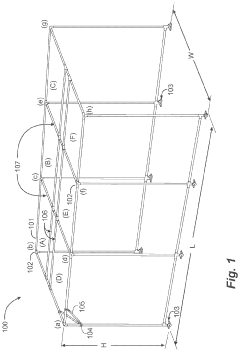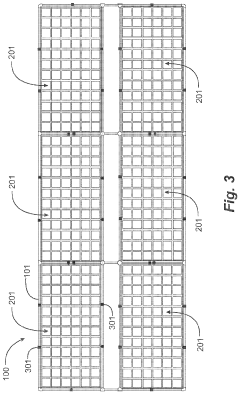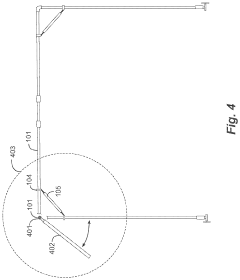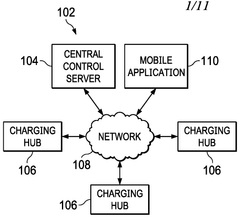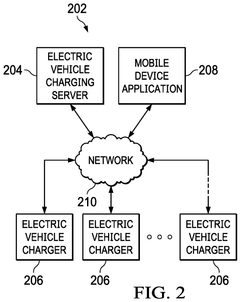How to Integrate Solar Inverters with EV Charging Stations?
JUL 17, 20259 MIN READ
Generate Your Research Report Instantly with AI Agent
Patsnap Eureka helps you evaluate technical feasibility & market potential.
Solar-EV Integration Background and Objectives
The integration of solar inverters with electric vehicle (EV) charging stations represents a significant technological convergence in the realm of sustainable energy and transportation. This fusion aims to harness the power of renewable solar energy to fuel the growing demand for electric vehicle charging infrastructure. The evolution of this technology can be traced back to the early 2010s when both solar power generation and electric vehicles began to gain mainstream traction.
As solar photovoltaic (PV) technology has become more efficient and cost-effective, its potential to power EV charging stations has become increasingly apparent. Concurrently, the rapid growth of the electric vehicle market has created a pressing need for widespread, sustainable charging solutions. The intersection of these two trends has given rise to the concept of solar-powered EV charging stations, which promise to reduce grid dependency and lower the carbon footprint of electric transportation.
The primary objective of integrating solar inverters with EV charging stations is to create a synergistic system that maximizes the use of clean, renewable energy for vehicle charging. This integration aims to address several key challenges, including reducing the strain on the electrical grid during peak charging times, minimizing the carbon emissions associated with EV charging, and enhancing the overall sustainability of the transportation sector.
From a technical perspective, the goal is to develop efficient and reliable systems that can seamlessly convert solar DC power to AC for EV charging, manage energy flow between solar panels, batteries, and charging stations, and optimize charging schedules based on solar availability and grid conditions. This integration also seeks to improve the economic viability of EV charging infrastructure by reducing operational costs and potentially generating revenue through grid services.
Looking ahead, the technology trajectory for solar-EV integration is focused on advancing smart charging algorithms, enhancing energy storage capabilities, and improving the overall system efficiency. Future developments aim to create bidirectional charging systems that not only charge vehicles but also allow them to feed energy back into the grid or power homes, further integrating EVs into the broader energy ecosystem.
As this technology evolves, it is expected to play a crucial role in the transition towards sustainable transportation and renewable energy adoption. The successful integration of solar inverters with EV charging stations has the potential to accelerate the deployment of charging infrastructure, particularly in areas with limited grid capacity, and contribute significantly to the decarbonization of both the energy and transportation sectors.
As solar photovoltaic (PV) technology has become more efficient and cost-effective, its potential to power EV charging stations has become increasingly apparent. Concurrently, the rapid growth of the electric vehicle market has created a pressing need for widespread, sustainable charging solutions. The intersection of these two trends has given rise to the concept of solar-powered EV charging stations, which promise to reduce grid dependency and lower the carbon footprint of electric transportation.
The primary objective of integrating solar inverters with EV charging stations is to create a synergistic system that maximizes the use of clean, renewable energy for vehicle charging. This integration aims to address several key challenges, including reducing the strain on the electrical grid during peak charging times, minimizing the carbon emissions associated with EV charging, and enhancing the overall sustainability of the transportation sector.
From a technical perspective, the goal is to develop efficient and reliable systems that can seamlessly convert solar DC power to AC for EV charging, manage energy flow between solar panels, batteries, and charging stations, and optimize charging schedules based on solar availability and grid conditions. This integration also seeks to improve the economic viability of EV charging infrastructure by reducing operational costs and potentially generating revenue through grid services.
Looking ahead, the technology trajectory for solar-EV integration is focused on advancing smart charging algorithms, enhancing energy storage capabilities, and improving the overall system efficiency. Future developments aim to create bidirectional charging systems that not only charge vehicles but also allow them to feed energy back into the grid or power homes, further integrating EVs into the broader energy ecosystem.
As this technology evolves, it is expected to play a crucial role in the transition towards sustainable transportation and renewable energy adoption. The successful integration of solar inverters with EV charging stations has the potential to accelerate the deployment of charging infrastructure, particularly in areas with limited grid capacity, and contribute significantly to the decarbonization of both the energy and transportation sectors.
Market Analysis for Solar-Powered EV Charging
The market for solar-powered EV charging stations is experiencing rapid growth, driven by the convergence of renewable energy adoption and the increasing popularity of electric vehicles. This synergy creates a compelling value proposition for consumers, businesses, and governments alike, as it addresses both environmental concerns and the practical needs of EV owners.
The global EV charging station market is projected to expand significantly in the coming years, with solar-powered solutions playing an increasingly important role. Factors contributing to this growth include government incentives for clean energy adoption, declining costs of solar technology, and the rising demand for sustainable transportation solutions.
In terms of regional distribution, Europe and North America currently lead in the deployment of solar-powered EV charging infrastructure. However, Asia-Pacific is expected to witness the fastest growth rate, particularly in countries like China and India, where both solar energy adoption and EV sales are surging.
The market can be segmented into residential, commercial, and public charging stations. Commercial installations, such as those in shopping centers, office parks, and hotels, are showing particularly strong growth potential. These locations benefit from the dual advantages of providing a valuable service to customers while potentially generating revenue from excess solar power fed back into the grid.
Key market drivers include the increasing range anxiety among EV owners, which solar-powered charging stations can help alleviate by providing off-grid charging options. Additionally, the growing focus on reducing carbon footprints in urban areas is prompting cities to invest in sustainable charging infrastructure.
Challenges in the market include the initial high installation costs, which can be a barrier for smaller businesses or municipalities. There are also technical considerations, such as optimizing energy storage to ensure consistent charging capabilities during periods of low sunlight.
Despite these challenges, the long-term outlook for the solar-powered EV charging market remains highly positive. As battery technology improves and solar panel efficiency increases, the economic case for these integrated systems becomes even more compelling. Furthermore, the development of smart grid technologies is expected to enhance the integration of solar-powered charging stations into broader energy management systems.
In conclusion, the market for solar-powered EV charging stations represents a high-growth sector at the intersection of renewable energy and sustainable transportation. As technology advances and costs decrease, this market is poised for substantial expansion, offering significant opportunities for businesses and contributing to the broader transition towards a cleaner, more sustainable energy ecosystem.
The global EV charging station market is projected to expand significantly in the coming years, with solar-powered solutions playing an increasingly important role. Factors contributing to this growth include government incentives for clean energy adoption, declining costs of solar technology, and the rising demand for sustainable transportation solutions.
In terms of regional distribution, Europe and North America currently lead in the deployment of solar-powered EV charging infrastructure. However, Asia-Pacific is expected to witness the fastest growth rate, particularly in countries like China and India, where both solar energy adoption and EV sales are surging.
The market can be segmented into residential, commercial, and public charging stations. Commercial installations, such as those in shopping centers, office parks, and hotels, are showing particularly strong growth potential. These locations benefit from the dual advantages of providing a valuable service to customers while potentially generating revenue from excess solar power fed back into the grid.
Key market drivers include the increasing range anxiety among EV owners, which solar-powered charging stations can help alleviate by providing off-grid charging options. Additionally, the growing focus on reducing carbon footprints in urban areas is prompting cities to invest in sustainable charging infrastructure.
Challenges in the market include the initial high installation costs, which can be a barrier for smaller businesses or municipalities. There are also technical considerations, such as optimizing energy storage to ensure consistent charging capabilities during periods of low sunlight.
Despite these challenges, the long-term outlook for the solar-powered EV charging market remains highly positive. As battery technology improves and solar panel efficiency increases, the economic case for these integrated systems becomes even more compelling. Furthermore, the development of smart grid technologies is expected to enhance the integration of solar-powered charging stations into broader energy management systems.
In conclusion, the market for solar-powered EV charging stations represents a high-growth sector at the intersection of renewable energy and sustainable transportation. As technology advances and costs decrease, this market is poised for substantial expansion, offering significant opportunities for businesses and contributing to the broader transition towards a cleaner, more sustainable energy ecosystem.
Technical Challenges in Solar-EV Integration
The integration of solar inverters with EV charging stations presents several significant technical challenges that need to be addressed for successful implementation. One of the primary issues is the synchronization of power flow between the solar panels, the grid, and the EV charging stations. Solar energy production is inherently variable, depending on weather conditions and time of day, while EV charging demands can be unpredictable and potentially high-load.
Managing this variability requires sophisticated power management systems capable of real-time monitoring and control. These systems must balance the power input from solar panels with the charging requirements of EVs, while also interfacing with the grid for supplementary power or excess energy storage. Developing algorithms that can efficiently manage this complex energy flow is a significant technical hurdle.
Another challenge lies in the power conversion process. Solar panels produce DC power, while the grid operates on AC. EV batteries, however, require DC power for charging. This necessitates multiple conversion stages, potentially leading to energy losses and reduced overall system efficiency. Designing high-efficiency, bi-directional inverters that can handle these conversions with minimal losses is crucial for the viability of integrated solar-EV charging systems.
The integration also raises concerns about power quality and grid stability. Large-scale EV charging can introduce harmonics and power factor issues into the grid, potentially affecting nearby electrical equipment. When combined with the variable nature of solar power, this can lead to voltage fluctuations and other power quality issues. Developing robust control systems and power conditioning equipment to mitigate these effects is essential.
Energy storage integration presents another set of challenges. To maximize the use of solar energy and provide a buffer for peak charging demands, many integrated systems incorporate battery storage. However, this adds complexity to the system design and control algorithms. Determining the optimal size and type of energy storage, as well as managing its charging and discharging cycles to maximize lifespan and efficiency, requires sophisticated energy management strategies.
Lastly, ensuring the reliability and longevity of the integrated system is a significant technical challenge. The components of solar-EV charging stations are exposed to various environmental stresses, including temperature fluctuations, humidity, and potentially harsh weather conditions. Developing robust, weather-resistant designs that can maintain high performance over extended periods is crucial for the widespread adoption of this technology.
Managing this variability requires sophisticated power management systems capable of real-time monitoring and control. These systems must balance the power input from solar panels with the charging requirements of EVs, while also interfacing with the grid for supplementary power or excess energy storage. Developing algorithms that can efficiently manage this complex energy flow is a significant technical hurdle.
Another challenge lies in the power conversion process. Solar panels produce DC power, while the grid operates on AC. EV batteries, however, require DC power for charging. This necessitates multiple conversion stages, potentially leading to energy losses and reduced overall system efficiency. Designing high-efficiency, bi-directional inverters that can handle these conversions with minimal losses is crucial for the viability of integrated solar-EV charging systems.
The integration also raises concerns about power quality and grid stability. Large-scale EV charging can introduce harmonics and power factor issues into the grid, potentially affecting nearby electrical equipment. When combined with the variable nature of solar power, this can lead to voltage fluctuations and other power quality issues. Developing robust control systems and power conditioning equipment to mitigate these effects is essential.
Energy storage integration presents another set of challenges. To maximize the use of solar energy and provide a buffer for peak charging demands, many integrated systems incorporate battery storage. However, this adds complexity to the system design and control algorithms. Determining the optimal size and type of energy storage, as well as managing its charging and discharging cycles to maximize lifespan and efficiency, requires sophisticated energy management strategies.
Lastly, ensuring the reliability and longevity of the integrated system is a significant technical challenge. The components of solar-EV charging stations are exposed to various environmental stresses, including temperature fluctuations, humidity, and potentially harsh weather conditions. Developing robust, weather-resistant designs that can maintain high performance over extended periods is crucial for the widespread adoption of this technology.
Current Solar-EV Integration Solutions
01 Grid-tied solar inverter systems
Grid-tied solar inverter systems are designed to connect solar panels to the utility grid. These systems convert DC power from solar panels into AC power compatible with the grid, allowing for bidirectional power flow. They often include features like maximum power point tracking (MPPT) and anti-islanding protection for safety and efficiency.- Grid-tied solar inverter systems: Grid-tied solar inverter systems are designed to connect solar panels to the utility grid. These systems convert DC power from solar panels to AC power compatible with the grid, allowing for bidirectional power flow. They often include features like maximum power point tracking (MPPT) and anti-islanding protection for safety and efficiency.
- Microinverter technology: Microinverters are small inverters attached to individual solar panels or small groups of panels. They convert DC to AC at the panel level, offering advantages such as improved efficiency, easier system design, and better performance in partial shading conditions. Microinverters also provide panel-level monitoring and can enhance system reliability.
- Power optimization and management: Solar inverters incorporate various power optimization and management techniques to maximize energy yield and system efficiency. These may include advanced MPPT algorithms, reactive power control, and intelligent power management systems that can adapt to changing environmental conditions and grid requirements.
- Safety and protection features: Solar inverters integrate multiple safety and protection features to ensure reliable operation and prevent damage to the system or grid. These may include ground fault detection, surge protection, over/under voltage protection, and anti-islanding functionality. Advanced monitoring and diagnostic capabilities are also incorporated to detect and respond to potential issues.
- Smart grid integration and communication: Modern solar inverters are designed with smart grid integration capabilities, allowing for seamless communication with utility networks and energy management systems. These inverters can support grid stability through features like frequency regulation, voltage support, and demand response. They often incorporate advanced communication protocols for remote monitoring and control.
02 Microinverter technology
Microinverters are small inverters attached to individual solar panels or small groups of panels. They convert DC to AC at the panel level, offering advantages such as improved efficiency, better performance in partial shading conditions, and easier system scalability. Microinverters also provide panel-level monitoring capabilities.Expand Specific Solutions03 Power optimization and management
Solar inverters incorporate various power optimization and management techniques to maximize energy yield and system efficiency. These include advanced MPPT algorithms, reactive power control, and intelligent power management systems that can adapt to changing environmental conditions and grid requirements.Expand Specific Solutions04 Safety and protection features
Solar inverters integrate multiple safety and protection features to ensure reliable operation and prevent damage to the system or grid. These include ground fault detection, surge protection, over/under voltage protection, and anti-islanding functionality. Advanced monitoring and communication capabilities are also incorporated for remote diagnostics and control.Expand Specific Solutions05 Multi-level and modular inverter designs
Multi-level and modular inverter designs are employed to improve efficiency, power quality, and scalability of solar inverter systems. These designs use multiple power stages or modules to achieve higher power ratings, reduce harmonic distortion, and enhance system reliability through redundancy.Expand Specific Solutions
Key Players in Solar-EV Integration Industry
The integration of solar inverters with EV charging stations is an emerging technology at the intersection of renewable energy and electric mobility. The market is in its early growth stage, with significant potential for expansion as both solar power adoption and EV sales increase globally. The technology's maturity is evolving rapidly, with key players like Huawei Digital Power, Tesla, and BYD leading innovation. These companies are leveraging their expertise in both solar and EV sectors to develop integrated solutions. Other notable contributors include State Grid Corp. of China and Vitesco Technologies, focusing on grid integration and power electronics respectively. The competitive landscape is diverse, with traditional energy companies, automotive manufacturers, and tech giants all vying for market share in this promising field.
Huawei Digital Power Technologies Co Ltd
Technical Solution: Huawei's FusionSolar Smart PV Solution integrates solar inverters with EV charging stations, creating a comprehensive energy management system. The solution utilizes bi-directional inverters that enable Vehicle-to-Grid (V2G) functionality, allowing EVs to both charge from and discharge to the grid[1]. The system incorporates AI-driven algorithms to optimize energy flow between solar panels, EV chargers, and the grid, maximizing renewable energy utilization. Huawei's solution also features cloud-based monitoring and control, enabling real-time management of energy distribution and charging schedules[2]. The integration is further enhanced by Huawei's smart power electronic devices, which ensure high conversion efficiency and grid stability[3].
Strengths: Advanced AI algorithms for energy optimization, comprehensive V2G functionality, and seamless integration with existing grid infrastructure. Weaknesses: Potential high initial costs and reliance on proprietary technology ecosystem.
State Grid Corp. of China
Technical Solution: State Grid's approach to integrating solar inverters with EV charging stations focuses on large-scale, grid-level solutions. Their system utilizes advanced power electronics to manage the bidirectional flow of energy between solar installations, EV charging stations, and the main grid. State Grid has implemented smart grid technologies that enable real-time monitoring and control of distributed energy resources, including solar inverters and EV chargers[7]. Their solution incorporates predictive algorithms to forecast solar generation and EV charging demand, optimizing energy distribution. State Grid has also developed a standardized communication protocol for seamless integration of various solar inverters and EV charging equipment from different manufacturers[8]. The company's approach emphasizes grid stability and reliability while maximizing the utilization of renewable energy sources.
Strengths: Large-scale implementation capability, focus on grid stability, and standardized protocols for equipment integration. Weaknesses: Potential challenges in adapting to rapidly evolving technologies and slower implementation due to regulatory processes.
Innovative Solar Inverter-EV Charger Designs
Portable Solar Carport System
PatentActiveUS20220376651A1
Innovation
- A portable solar carport system with a framework of metal tubing and wheel assemblies, allowing the solar panels to be easily moved and stored, featuring bifacial panels and a deployable design that can be rolled into a garage for protection, with integrated circuitry and an inverter for electricity generation.
A method and device for converting standalone EV charging stations into intelligent stations with remote communications connectivity and control
PatentPendingAU2024287157A1
Innovation
- A smart charging system that converts dumb chargers into intelligent ones using an adapter with wireless communications and control circuitry, enabling remote monitoring and reservation of charging stations, and integrating with a central management system for efficient energy distribution and payment processing.
Regulatory Framework for Solar-EV Charging Systems
The regulatory framework for solar-EV charging systems is a complex and evolving landscape that plays a crucial role in shaping the integration of solar inverters with EV charging stations. As the demand for clean energy and sustainable transportation grows, governments and regulatory bodies worldwide are developing and refining policies to support this integration.
At the national level, many countries have implemented incentive programs and tax credits to encourage the adoption of solar-powered EV charging infrastructure. These initiatives often include grants, rebates, and accelerated depreciation schemes for businesses and individuals investing in such systems. For instance, the United States offers the Investment Tax Credit (ITC) for solar installations, which can be applied to solar-EV charging projects.
Grid interconnection standards are a critical component of the regulatory framework. These standards ensure that solar-EV charging systems can safely and efficiently connect to the existing power grid. Organizations such as the Institute of Electrical and Electronics Engineers (IEEE) have developed guidelines like IEEE 1547, which provides technical specifications for the interconnection of distributed energy resources, including solar inverters.
Safety regulations are paramount in the deployment of solar-EV charging systems. Electrical codes, such as the National Electrical Code (NEC) in the United States, have been updated to include specific provisions for EV charging equipment and solar photovoltaic systems. These codes address issues like proper wiring, grounding, and overcurrent protection to ensure the safety of users and installers.
Environmental regulations also play a significant role in shaping the solar-EV charging landscape. Many jurisdictions have implemented renewable portfolio standards (RPS) that require utilities to source a certain percentage of their energy from renewable sources. These standards indirectly support the growth of solar-EV charging infrastructure by creating a favorable market for solar energy generation.
Local zoning laws and building codes are increasingly being adapted to accommodate solar-EV charging installations. Some municipalities have streamlined permitting processes for these systems, reducing bureaucratic hurdles and installation times. Additionally, certain regions have implemented "solar-ready" or "EV-ready" building codes that require new constructions to include the necessary infrastructure for future solar and EV charging installations.
As the technology continues to evolve, regulators are also addressing emerging challenges such as cybersecurity and data privacy. Guidelines are being developed to protect the communication systems between solar inverters, EV charging stations, and grid operators from potential cyber threats.
The regulatory landscape for solar-EV charging systems is dynamic, with policies often varying between countries, states, and even municipalities. Stakeholders in this field must stay informed about the latest regulatory developments and actively engage with policymakers to ensure a supportive framework for the continued growth and innovation in solar-EV charging integration.
At the national level, many countries have implemented incentive programs and tax credits to encourage the adoption of solar-powered EV charging infrastructure. These initiatives often include grants, rebates, and accelerated depreciation schemes for businesses and individuals investing in such systems. For instance, the United States offers the Investment Tax Credit (ITC) for solar installations, which can be applied to solar-EV charging projects.
Grid interconnection standards are a critical component of the regulatory framework. These standards ensure that solar-EV charging systems can safely and efficiently connect to the existing power grid. Organizations such as the Institute of Electrical and Electronics Engineers (IEEE) have developed guidelines like IEEE 1547, which provides technical specifications for the interconnection of distributed energy resources, including solar inverters.
Safety regulations are paramount in the deployment of solar-EV charging systems. Electrical codes, such as the National Electrical Code (NEC) in the United States, have been updated to include specific provisions for EV charging equipment and solar photovoltaic systems. These codes address issues like proper wiring, grounding, and overcurrent protection to ensure the safety of users and installers.
Environmental regulations also play a significant role in shaping the solar-EV charging landscape. Many jurisdictions have implemented renewable portfolio standards (RPS) that require utilities to source a certain percentage of their energy from renewable sources. These standards indirectly support the growth of solar-EV charging infrastructure by creating a favorable market for solar energy generation.
Local zoning laws and building codes are increasingly being adapted to accommodate solar-EV charging installations. Some municipalities have streamlined permitting processes for these systems, reducing bureaucratic hurdles and installation times. Additionally, certain regions have implemented "solar-ready" or "EV-ready" building codes that require new constructions to include the necessary infrastructure for future solar and EV charging installations.
As the technology continues to evolve, regulators are also addressing emerging challenges such as cybersecurity and data privacy. Guidelines are being developed to protect the communication systems between solar inverters, EV charging stations, and grid operators from potential cyber threats.
The regulatory landscape for solar-EV charging systems is dynamic, with policies often varying between countries, states, and even municipalities. Stakeholders in this field must stay informed about the latest regulatory developments and actively engage with policymakers to ensure a supportive framework for the continued growth and innovation in solar-EV charging integration.
Environmental Impact Assessment
The integration of solar inverters with EV charging stations presents a significant opportunity for environmental improvement in the transportation and energy sectors. This combination has the potential to reduce greenhouse gas emissions and mitigate the overall carbon footprint of electric vehicle charging infrastructure.
By harnessing solar energy to power EV charging stations, this integration can significantly decrease reliance on grid electricity, which often includes a mix of fossil fuel-based power generation. The reduction in grid dependency leads to a substantial decrease in indirect emissions associated with EV charging. Studies have shown that solar-powered charging stations can reduce CO2 emissions by up to 89% compared to conventional grid-powered stations, depending on the local energy mix and solar resource availability.
Furthermore, the environmental benefits extend beyond emissions reduction. The use of solar energy in EV charging stations promotes the expansion of renewable energy infrastructure, contributing to the overall greening of the power sector. This aligns with global efforts to transition towards cleaner energy sources and supports the achievement of climate change mitigation goals.
The integration also addresses concerns about the increased electricity demand from widespread EV adoption. By utilizing solar power, the strain on the existing power grid is reduced, potentially avoiding the need for additional fossil fuel-based power plants to meet growing energy needs. This aspect is particularly crucial in regions where grid infrastructure is already strained or heavily reliant on non-renewable sources.
However, it is important to consider the full lifecycle environmental impact of this integration. The production of solar panels and inverters involves resource extraction and manufacturing processes that have their own environmental footprints. While these impacts are generally outweighed by the long-term benefits of clean energy generation, they should be factored into comprehensive environmental assessments.
The land use implications of solar-integrated EV charging stations must also be evaluated. In urban areas, rooftop installations can maximize space efficiency, while in rural or highway locations, ground-mounted solar arrays may require careful consideration of land use changes and potential impacts on local ecosystems.
Lastly, the end-of-life management of solar panels and inverters is an important environmental consideration. Developing efficient recycling processes for these components will be crucial to minimize waste and recover valuable materials, further enhancing the overall environmental benefits of this integration.
By harnessing solar energy to power EV charging stations, this integration can significantly decrease reliance on grid electricity, which often includes a mix of fossil fuel-based power generation. The reduction in grid dependency leads to a substantial decrease in indirect emissions associated with EV charging. Studies have shown that solar-powered charging stations can reduce CO2 emissions by up to 89% compared to conventional grid-powered stations, depending on the local energy mix and solar resource availability.
Furthermore, the environmental benefits extend beyond emissions reduction. The use of solar energy in EV charging stations promotes the expansion of renewable energy infrastructure, contributing to the overall greening of the power sector. This aligns with global efforts to transition towards cleaner energy sources and supports the achievement of climate change mitigation goals.
The integration also addresses concerns about the increased electricity demand from widespread EV adoption. By utilizing solar power, the strain on the existing power grid is reduced, potentially avoiding the need for additional fossil fuel-based power plants to meet growing energy needs. This aspect is particularly crucial in regions where grid infrastructure is already strained or heavily reliant on non-renewable sources.
However, it is important to consider the full lifecycle environmental impact of this integration. The production of solar panels and inverters involves resource extraction and manufacturing processes that have their own environmental footprints. While these impacts are generally outweighed by the long-term benefits of clean energy generation, they should be factored into comprehensive environmental assessments.
The land use implications of solar-integrated EV charging stations must also be evaluated. In urban areas, rooftop installations can maximize space efficiency, while in rural or highway locations, ground-mounted solar arrays may require careful consideration of land use changes and potential impacts on local ecosystems.
Lastly, the end-of-life management of solar panels and inverters is an important environmental consideration. Developing efficient recycling processes for these components will be crucial to minimize waste and recover valuable materials, further enhancing the overall environmental benefits of this integration.
Unlock deeper insights with Patsnap Eureka Quick Research — get a full tech report to explore trends and direct your research. Try now!
Generate Your Research Report Instantly with AI Agent
Supercharge your innovation with Patsnap Eureka AI Agent Platform!
